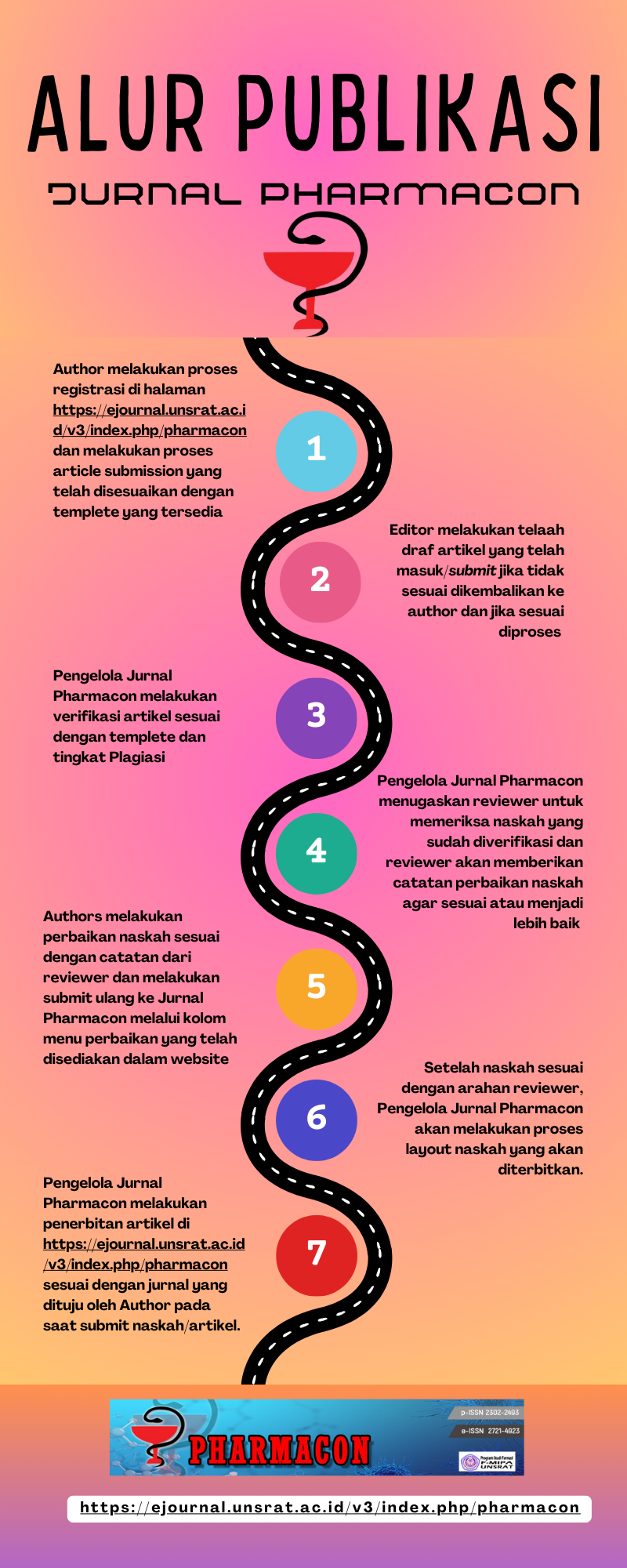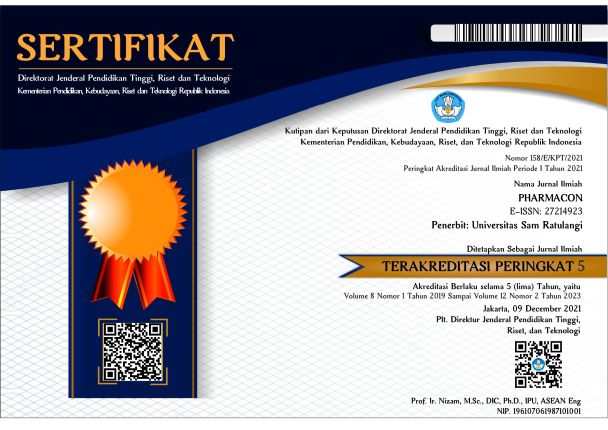Antibacterial Efficay Test of Ethanol Extract of Yaki Areca Nut (Areca vestiaria) Against the Growth of Propionibacterium acnes, the Cause of Acne.
DOI:
https://doi.org/10.35799/pha.13.2024.55524Keywords:
Acne vulgaris, Antibacterial activity, Areca nut, Propionibacterium acnes.Abstract
A bacterial skin infection that is often experienced by everyone, especially in adolescence, is acne(Acne vulgaris). Acne is caused by the accumulation of excess oil in the skin, thus becoming a medium for bacterial growth, which causes acne. The use of natural antibiotics can be a therapeutic option in the treatment of acne. One of the plants that potentially has antbacterial activity is Pinang Yaki (Areca vestiaria). The purpose of this study was to determine the antibacterial activity of ethanol extract of areca nut fruit against the growth of Propionibacterium acnes that causes acne. The test of antibacterial activity of areca nut extract with the pitting method found that at a concentration of 10% the antibacterial activity was included in the weak group, 20% was included in the medium group, while those included in the strong group in inhibiting the growth of Propionibacterium acnes were extracts with concentrations of 40%, 60% and 80%..
References
Afifi, R., & Erlin. (2019). Uji Anti Bakteri Ekstrak Daun Jambu Biji (Psidium guajava L) Terhadap Zona Hambat Bakteri Jerawat Propionibacterium acnes Secara In Vitro. Jurnal Kesehatan Bakti Tunas Husada.vol 17(2): 321-330.
Aji, P, D. (2018). Pengaruh Ukuran Partikel Simplisia Terhadap Kadar Genistein Pada Ekstaksi Tempe. Universitas Sanata Dharma. 1-3.
Arjuna PW. (2020) Perbandingan Daya Hambat Kombinasi Ekstrak Lidah Buaya (Aloe veraL.) Dengan Antibiotik Eritromisin terhadap Bakteri Staphylococcus aureus Penyabab Ulkus diabetik. Published online:1-67.
Aviany B, H dan Pujiyanto, S. (2020). Analisis Efektivitas Probiotik di Dalam Produk Kecantikan sebagai Antibakteri terhadap Bakteri Staphylococcus epidermidis. Jurnal Berkala Bioteknologi. 3 (2). 25-30.
Bauman, R, W, (2012). Microbiology:With Diseases by Body Sistem. San Fransisco: Pearson Education, Inc.
Bramono K, Budimulja U. (2019). Dermatomikosis. In: Menaldi SL, Bramono K, Indriatmi W, editors. Ilmu penyakit kulit dan kelamin. 7th Ed. Jakarta: BP FKUI;. p. 103-19.
Ebimieowei Etebu; Ibemologi Arikekpar. (2016). Antibiotics: Classification and mechanisms of action with emphasis on molecular perspectives. IJAMBR, 6.
George, R. M., & Sridharan, R. (2018). Factors aggravating or precipitating acne in Indian adults: A hospital-based study of 110 cases. Indian Journal of Dermatology. vol 63(4): 328–331.
Haryanti S, Larasati R. D, Agusta H, (2020). Optimasi Waktu Maserasi dan Konsentrasi Ekstrak Daun Sirih Hijau (Piper betle linn) Dalam Pembuatan Gel Antiseptik Kulit. Jurnal Konversi. Jakarta. 9 (2) : 17-24
Hendra R, Ahmad S, Sukari A, Shukor MY, Oskoueian E.(2011). Flavonoid analyses and antimicrobial activity of various parts of Phaleria macrocarpa (Scheff.) Boerl fruit. Int J Mol Sci.;12: 3422-3431.
Hidayat, F. (2019). Senyawa Metabolit Sekunder Dan Aktivitas Antibakteri Serta Antioksidan Dari Ganoderma Lucidum. Surabaya: Institut Sepuluh Nopember.
Hidayati AN. Folikulitis. In: Hidayati AN, Damayanti, Sari M, (2019). Buku seri dermatologi dan venereologi 1: Infeksi bakteri di kulit. Surabaya: Airlangga University Press;. p. 21–8
Jawetz, Melnick, dan Adelberg, (2012). Mikrobiologi Kedokteran. Edisi 23
Karim, A., Marliana, & Sartini. (2018). Efektifitas beberapa produk pembersih wajah antiacne terhadap bakteri penyebab jerawat Propionibacterium acnes. Jurnal Biologi Lingkungan, Industri, Kesehatan. 5(1): 31–41.
Kumalasari.(2018). Uji Aktivitas Antibakteri Ekstrak Etil Asetat 96% Daun Myana ( Coleus arthropurpureus L. Benth) Terhadap Pertumbuhan Bakteri Staphylococcus aureus.Tulungagung:
Kusumawardani. (2014). Skrining Aktivitas Antibakteri Eksktrak Purwoceng (Pimpinella alpina Molk.) Terhadap pertumbuhan bakteri Escherichia coli DAN Staphylococcus aureus.
Madelina, W. & Sulistiyaningsih. (2018). Review: Resistensi Antibiotik Pada Terapi Pengobatan Jerawat. Jurnal Farmaka, 105-117.
Marjoni, R. 2016. Dasar-Dasar Fitokimia. Jakarta : Trans Info Media.
Nugroho, A.,(2017).Buku Ajar Teknologi Bahan Alam.Banjarmasin:Universitas Lambung Mangkurat Press
Nurjanah, N., Aprilia, B. E., Fransiskayana, A., Rahmawati, M., & Nurhayati, T. (2018). Senyawa bioaktif rumput laut dan ampas teh sebagai antibakteri dalam formula masker wajah. Jurnal Pengolahan Hasil Perikanan Indonesia. 21(2): 304-316.
Prayitno, S. A. & Rahim, A. R. (2020) ‘The Comparison of Extracts (Ethanol And Aquos Solvents) Muntingia calabura Leaves on Total Phenol, Flavonid And Antioxidant (Ic50) Properties’, Kontribusia (Research Dissemination for Community Development), 3(2).
Purmaningsih, N., H. K. (2017). Uji Aktivitas Antibakteri Ekstrak Temulawak (Curcuma Xanthorrhiza) Terhadap Bakteri Escherichia Coli Atcc 11229 Dan Staphylococcus Aureus Atcc 25923. Jurnal Penelitian Saintek, 140-147.
Redwik, D, U, W., Simbala, H, E, I., Edy, H, J.,( 2019). Identifikasi Fitokimia Dan Uji Daya Hambat Dari Ekstrak Etanol Tangkai Buah Pinang Yaki (Areca Vestiaria Giseke) Terhadap Bakteri Staphylococcus aureus, Escherichia coli, Dan Pseudomonas aeruginosa. Jurnal Pharmacon. 8 (4) : 936-944.
Retnaningsih, A., Primadiamanti, A., Masisa., I. (2019). Uji Daya Hambat Ekstrak Etanol Biji Pepaya Terhadap Bakteri Escherichia Coli Danshigella Dysentriaedengan Metode Difusi Sumuran. Jurnal Analisis Farmasi. 4 (2) : 122 - 129
Rollando, (2019). Senyawa Antibakteri Dari Fungi Endofit. Malang: CV. Seribu Bintang. Halaman 26.
Rundengan C. H., Fatimawali, Simbala H., (2017). Uji Daya Hambat Ekstrak Etanol Biji Pinang Yaki (Areca Vestiaria) Terhadap Bakteri Stapyhlococcus Aureus, Escherichia Coli, Pseudomonas Aeruginosa. Jurnal Ilmiah Farmasi, Pharmacon. 6 (1) : 37 – 46.
Sangkoy, W. J., Simbala H. E. I., Rumondor E. M.,(2023). Aktivitas Antibakteri Ekstrak Etanol Daun Pinang Yaki (Areca Vestiaria) Terhadap Bakteri Staphylococcus Aureus, Escherichia Coli, Dan Pseudomonas Aeruginosa. Jurnal Pharmacon. 12 (1) : 133 - 139.
Sari,Y. (2017). Uji Aktivitas Antibakteri Fraksi Dan Senyawa Aktif Daun Kardia (Bellucia pentamera Naudin) Terhadap Escherichia coli dan Staphylococcus aureus. Indralaya: Universitas Sriwijawa.
Sari, R., Apridamayandi, P., Pratiwi., (2022). Efektivitas SNEDDS Kombinasi Fraksi Etil Asetat Daun Cengkodok (Melasthoma malabathricum)-Antibiotik terhadap Bakteri Hasil Isolat Dari Pasien Ulkus Diabetik. Pharmaceutical Joutnal Of Indonesia. 7(2). 105-114
Sari, F.P. dan S. M. Sari. (2011). Ekstraksi Zat Aktif Antimikroba dari Tumbuhan Yodium (Jatropha multifida Linn) sebgai Bahan Baku Alternatif Antibiotik Alami. Semarang: Fakultas Teknik Universitas Diponegoro. 2011.
Sibero, H. T., Putra, I. W. A., & Anggraini, D. I. (2019). Tatalaksana terkini Acne vulgaris. JK Unila. 3(2): 313–320
Simbala H E I, (2020). Potensi Pinang Yaki (Areca vestiaria) Sebagai Antikanker. CV. Patra Media Grafindo Bandung : Bandung.
Susanto, D., Sudrajat dan R. Ruga. (2012). Studi Kandungan Bahan Aktif Tumbuhan Meranti Merah (Shorea leprosula Miq) Sebagai Sumber Senyawa Antibakteri. Mulawarmnan Scientifie. 11 (2): 181-190.
Wibawa, I. G. A. E., & Winaya, K. K. (2019). Karakteristik penderita Acne vulgaris di Rumah Sakit Umum (RSU) Indera Denpasar periode 2014-2015. Jurnal Medika Udayana. 8(11): 1–4.
Yonanda, R, C., Dwi W., & Siti M., 2016. Pengaruh Ekstrak Etanol Daun Belimbing Wuluh (Averrhoa billimbi L.) Terhadap Daya Hambat Staphylococcus Epidermidis. Prodi Pendidikan Biologi FKIP Universitas Jember, Jember.
Downloads
Published
How to Cite
Issue
Section
License
Copyright (c) 2024 Daniel Pabundu, Herny Simbala, Yuanita Hariyanto

This work is licensed under a Creative Commons Attribution-NonCommercial 4.0 International License.
Authors who publish with this journal agree to the following terms:
- Authors retain copyright and grant the journal right of first publication with the work simultaneously licensed under a Creative Commons Attribution-NonCommercial 4.0 International License that allows others to share the work with an acknowledgement of the work's authorship and initial publication in this journal.
- Authors are permitted and encouraged to post their work online (e.g., in institutional repositories or on their website) prior to and during the submission process, as it can lead to productive exchanges, as well as earlier and greater citation of published work (See The Effect of Open Access)










